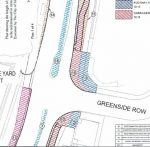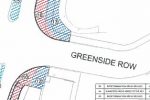RSO/17/13 Leith Street, Calton Road, Greenside Row, Waterloo Place
Living Streets Edinburgh Group objects to RSO 17/13 on the following grounds:
1) All – pavement widths
Leith Street is designated as a Strategic High Street, according to the Street Design Guidance adopted by the Council in 2015 (i). This specifies that the pavement should be a minimum width of 3 metres (2.5 metres allowed only in short sections), with a desirable minimum width of 4m or wider. We cannot determine the exact pavement widths from the drawings, but it is clear that the pavement widths proposed in the order are far below the Council’s own specified standards on both sides of the street.
(i) http://www.edinburgh.gov.uk/downloads/download/550/edinburgh_street_design_guidance
2) Crossing point of Leith Street East at Greenside Row
 The drawing seems to imply that the entire pavement both the north and south sides of the Greenside Row corner is re-determined as cycle way from both footway and carriageway (10, 12, 16, 13). This leaves no footway whatsoever exclusively for pedestrians crossing Greenside Row. The drawing suggest that pedestrians are expected to wait in a designated cycle way before crossing Greenside Row. This is a busy pavement at all times – and is already excessively busy at certain times of the year (eg during the August festivals). It is unacceptable that pedestrians at this location should mix with cyclists. Of course, it would also be also extremely unhelpful for cyclists to encounter pedestrians on the cycle track.
The drawing seems to imply that the entire pavement both the north and south sides of the Greenside Row corner is re-determined as cycle way from both footway and carriageway (10, 12, 16, 13). This leaves no footway whatsoever exclusively for pedestrians crossing Greenside Row. The drawing suggest that pedestrians are expected to wait in a designated cycle way before crossing Greenside Row. This is a busy pavement at all times – and is already excessively busy at certain times of the year (eg during the August festivals). It is unacceptable that pedestrians at this location should mix with cyclists. Of course, it would also be also extremely unhelpful for cyclists to encounter pedestrians on the cycle track.
3) Junction of Leith Street East at Greenside Row
 The corner radii of Greenside Row (at 10, 16) are excessively large, which will encourage vehicles to travel fast when entering and exiting Leith Street. This is an inappropriate design for a 20 mph street. The Street Design Guidance (see above) specifies that the maximum radius for a corner of this type of street is 3 metres, and although not shown, the radii proposed are clearly far in excess of this.
The corner radii of Greenside Row (at 10, 16) are excessively large, which will encourage vehicles to travel fast when entering and exiting Leith Street. This is an inappropriate design for a 20 mph street. The Street Design Guidance (see above) specifies that the maximum radius for a corner of this type of street is 3 metres, and although not shown, the radii proposed are clearly far in excess of this.
4) Cycle manoeuvres, Leith Street (west) to Greenside Row
We are unclear what manoeuvres cyclists are expected to make heading north from the west side of Leith Street (6) to join the cycle track on the east side (10). We are concerned at the risk of conflict between cyclists and pedestrians involved in this manoeuvre.
5) Junction of Leith Street (east) at Calton Road
 It is our understanding that the junction of Leith Street and Calton Road will be governed by a signalised crossing, although this does not appear to be indicated on the drawings. We would support this, so long as adequate pedestrian priority is provided in signal timings to permit the heavy pedestrian traffic to proceed effectively north/south. However, we have concerns that the cycle track on Leith Street heading south ends abruptly at Calton Road (10). There could be conflict at this junction between pedestrians and cyclists wishing to continue south, for example to the Bridges,
It is our understanding that the junction of Leith Street and Calton Road will be governed by a signalised crossing, although this does not appear to be indicated on the drawings. We would support this, so long as adequate pedestrian priority is provided in signal timings to permit the heavy pedestrian traffic to proceed effectively north/south. However, we have concerns that the cycle track on Leith Street heading south ends abruptly at Calton Road (10). There could be conflict at this junction between pedestrians and cyclists wishing to continue south, for example to the Bridges,
6) ‘Floating Bus Stop’ Leith Street (East).
 The drawing shows a ‘floating bus stop’ (17). Living Streets’ opposes the further introduction of this feature until an objective and thorough monitoring is completed on the first such floating stop, introduced on Leith Walk (ii). This is because we are concerned at the risk of conflict between pedestrians (especially elderly and or disabled bus passengers alighting from a bus) and cyclists, where the cycle way lies between the bus stop and the pavement. This would be especially the case if the cycle way is, as we think 2-way, so downhill (northbound) cyclists may be going quite fast. No such monitoring has yet taken place or been planned to our knowledge and so we therefore oppose the redeterminations introducing this feature.
The drawing shows a ‘floating bus stop’ (17). Living Streets’ opposes the further introduction of this feature until an objective and thorough monitoring is completed on the first such floating stop, introduced on Leith Walk (ii). This is because we are concerned at the risk of conflict between pedestrians (especially elderly and or disabled bus passengers alighting from a bus) and cyclists, where the cycle way lies between the bus stop and the pavement. This would be especially the case if the cycle way is, as we think 2-way, so downhill (northbound) cyclists may be going quite fast. No such monitoring has yet taken place or been planned to our knowledge and so we therefore oppose the redeterminations introducing this feature.
David Hunter
for Living Streets Edinburgh Group
Thorn House
5 Rose Street
Edinburgh
EH2 2PR
17 October 2017


